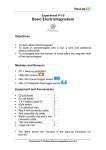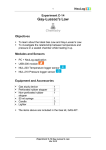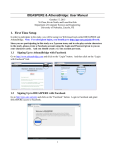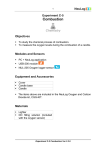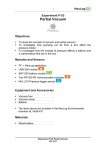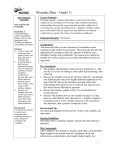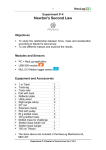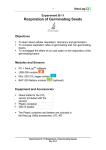Download Sound Isolation P-29
Transcript
1 Experiment P-29 Sound Isolation Objectives To observe through which materials sound travels better. To understand the concept of sound isolation. Modules and Sensors PC + NeuLog application USB-200 module NUL-212 Sound logger sensor Equipment and Accessories Audio device (or other steady sound source) Sound isolation sponge Felt Paper towels Sound isolation box Egg tray The items above (except for the audio device) are included in the NeuLog Sound kit, SND-KIT Experiment P-29 Sound Isolation Ver 3.0.4 2 Introduction Acoustic or sound isolation refers to technologies with materials and techniques developed to attenuate and/or isolate the level of sounds in a given space. Isolation is the prevention of a sound from penetrating or leaving a media. Isolation is achieved by using both absorbent and isolating materials. When an acoustic wave influences a constructive element, part of the energy is reflected, another part is absorbed and the rest is transmitted to the other side. The element offers isolation which is the difference between the incident and the transmitted energy. In order to acquire a good acoustic isolation various basic factors must be involved: Mass factor. Acoustic isolation is acquired mainly by the mass of the constructive elements: the larger the mass, the greater resistance opposes the bumping of the sound waves and the greater the attenuation. Multilayer factor. When dealing with constructive elements formed by many layers, a suitable arrangement of the layers can give a better acoustic isolation even to higher levels than the isolation that can be reached by the sum of each individual layer. Dissipation factor. Isolation is also better if an absorbent material is put between the two layers. In this activity we will use a sound sensor to measure different sound levels and study which materials are better isolators. Experiment P-29 Sound Isolation Ver 3.0.4 3 Procedure Experiment setup 1. Assemble a system like the one in the picture bellow. 2. Put the sound sensor on the table in front of the sound source. Try to predict which materials will isolate sound better. Note that the sensor has an opening on the top through which sound is sensed. Experiment P-29 Sound Isolation Ver 3.0.4 4 Sensor setup 3. Connect the USB-200 module 4. Check that the sound sensor USB-200 module. to the PC. is connected to the Note: The following software functions are explained in short. It is recommended to practice the NeuLog application functions (as described in the user manual) beforehand. 5. Run the NeuLog application and check that the sound sensor is identified. Experiment P-29 Sound Isolation Ver 3.0.4 5 Settings 6. Click on the On-line Experiment icon main icon bar. in the NeuLog 7. Click on the Sensor's Module box. 8. Click on the Range button. 9. Select the Level button to change the sensor's mode. 10. Close the Module setup dialog box. 11. Click on the Experiment Setup icon and set the: Experiment duration to 10 seconds Sampling rate to 10 per second Experiment P-29 Sound Isolation Ver 3.0.4 6 Testing and measurements 12. Turn on the audio device or other sound source without placing an isolating material. 13. Click on the Run Experiment icon measurement. 14. Click on the Show Functions icon , and then click on the sound button on the left of the screen. 15. Write the average sound level in the following table (below the sample data): to start the Sample experiment Isolating material Average sound level [dB] No isolating material 69.9 Sound isolation sponge 69.7 Felt 69.37 Egg tray 66.39 Isolating material No isolating material Sound isolation sponge Felt Egg tray Paper towels Sound isolation box Average sound level [dB] Experiment P-29 Sound Isolation Ver 3.0.4 7 16. Repeat the measurement placing an isolating material in front of the sound source and write the average sound level in the table. Continue in the same way with other isolating materials. Which material influences the most on the sound level? Challenge research 17. Place two materials together as two layers in front of the audio device. Summary questions 1. How good were your predictions about the efficiency of the sound isolators? 2. Which material is a good isolator? 3. Which material is a bad isolator? 4. What combination of isolators was the best? 5. Can you explain why certain materials are better isolators than others? Experiment P-29 Sound Isolation Ver 3.0.4








